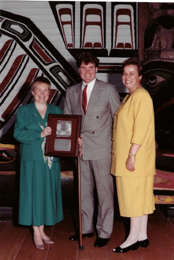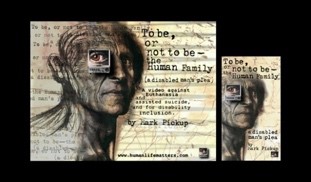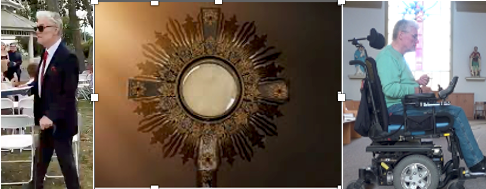An Interview with Mark Davis Pickup
- Profiles in Catholicism
- Sep 8, 2023
- 10 min read
Updated: Oct 2, 2023
by Gordon Nary

Gordon: What college did you attend, what was your favorite course, and why was it your favorite?
Mark: I attended the Northern Alberta Institute of Technology (NAIT) in Canada to study Radio and Television Arts during the early to mid-1970s. It’s hard to believe half a century has passed! Radio and Television Arts (RTA) taught the various aspects of production in both media from the technical and creative side to on-air broadcasting. We must remember that at that time, radio and television were the exclusive electronic mass media, particularly for news and current affairs.
Although I knew the importance of having a working knowledge the technical end of things, my main interest was television writing. I simply loved to write. While I enjoyed being on air, that was not my priority. My interest in television and radio writing expanded to feature stories and current affairs reporting. I loved fleshing out stories in depth and in a balanced, even-handed way. Unlike today, we were taught to report objectively, presenting only the pertinent facts on both sides of a story or issue. The worst transgression a student of broadcast journalism could make (and guarantee a failing mark) was to inject the slightest hint of personal opinions or bias into their reporting. It was a challenge because I’ve always been opinionated. But I loved the cardinal rule of objectivity and fairness. (Some of my instructors’ careers dated back to the early 1950s when television was still in its infancy and radio was king.)
I saw news and current affairs programming as noble professions. To paraphrase Joe Friday from the radio and television series Dragnet (1949-2003) “The facts, ma’am, just the facts.” That was how and what we were taught. Things are not like that now. News and current affairs are infused with political agendas (usually the left).
Gordon: What was one of your favorite memories when you were there?
Mark: Gosh, there’s so many. The first that comes to mind is when the college was celebrating its tenth anniversary in 1973. I took on myself to make a pitch to the Program Head of the Radio and Television Arts program to let me produce a radio campaign to celebrate NAIT’s anniversary. He bought in to the idea carte blanche. I wrote and produced public service ads, composed a jingle and recorded it with musicians and singers. It was great fun, taught me a lot, and was satisfying to hear the commercials on the radio. The Program Head like it, the President of the College liked it, and even the provincial government Minister of Advanced Education liked the campaign. It turned out better than I expected.
Gordon: When did you serve as Program Consultant with the Canadian Public Service?
Mark: After graduating from RTA, I worked for the Canadian Broadcasting Corporation (CBC) as a television commercial writer, but I also had an acute interest in community and social development. My father was naturally gifted this these areas. I saw his extraordinary talent of taking community-based ideas and making them a reality. He was able to bring together community stakeholders and different levels of government to achieve remarkable services and facilities for the local municipality. He let me observe him in action, in as much as was possible. Through sheer osmosis, a semblance of his ability rubbed off on me. In 1977, I started working for the federal government in community development and employment of indigenous Canadians. It was a springboard from broadcast writing to community development. In 1979, I was hired as the director of Family and Community Support Services for two Alberta towns, one of which was my hometown. Although my father had been dead for several years by that time, the family name still held in high regard. With no formal training, I got the job and moved back to the town with my wife and two young children. I guess town council thought I could pull off some of his magic. Was that intimidating? You bet it was! Surprisingly and happily, I discovered I was good at it. In that capacity my office developed programs such as skills training support for women entering or re-enter the workforce, family crisis care, quality daycare, children’s and seniors’ programs, a mentorship program for young offenders at risk of going to prison, and numerous other community-based programs and services.
Canada went into an economic recession from 1980-1983. It was a time of austerity. Municipal governments throughout the province went into a bunker mentality and started dissolving programs they saw as superfluous to essential bricks and mortar services. My program was axed. I found myself unemployed and unable to find work.
Let me veer off the path for a moment and share this story because it’s an illustration of how God has been present throughout my life, even when I didn’t know it. I don’t share it often because it seems too fantastic to be true. Some people even find it creepy or don’t believe it.
One day, after my daily search for a job, my wife said somebody called from the Multiple Sclerosis Society of Edmonton about an interview for a job opening they had for a Client Services Coordinator. I was puzzled. I didn’t remember sending them a resume or being in contact with them for possible employment (or anything else for that matter). With no other job prospects, I went to the interview, but not hopeful. I knew nothing about multiple sclerosis (it was before I was diagnosed with it) and knew nothing about the needs of people with the disease, and because I knew charitable organizations can’t afford to pay very well. My wife and I had worked out precisely the minimum income we needed to live. They offered me the job at exactly the salary we needed, right to the dollar. I accepted it. As Saint Jerome said, look a gift horse in the mouth?[1]
As the interview ended, I asked the executive director how they got my name? He snickered and said, “We were moving offices to this location. When the movers pulled the filing cabinets away from the wall at the other place, I heard something hit the floor. It was your resume. Your skills matched what we need for a coordinator of client services.” (Apparently, a few years early I had applied for the opening of Executive Director of the organization. I didn’t remember doing that. Somehow, my resume fell behind a filing cabinet and remained stuck halfway down until the filing cabinet was moved, then it fell to the floor.)
I could only take the stress of that job for six months. During that time, I saw the very worst MS can dish out. It’s a cruel disease that usually strikes young people between the ages of twenty and forty. I saw young people’s lives and careers and marriages destroyed, devastating paralysis, people bedridden, their hopes dashed, and their worst fears come true. Many wanted to die and all I could do was look at my shoes! I comforted so many heartbroken parents to see their sons or daughters lives crumble before their eyes!
I couldn’t take it. In 1983, I went to the cushy Canadian federal government’s employment and immigration commission again as a program consultant for community development as it pertained to employment training and funding, for the province of Alberta.
Aggressive multiple sclerosis struck me in 1984 and it became me who was on a rollercoaster of devastating attacks and remissions. It terrified me because I had seen what MS can do!
I’d lose the ability to walk and land up in a wheelchair or lose the use of my right arm.
I had painful spasticity, so severe it permanently twisted my spine.
My vision would become impaired. I couldn’t read.
My hearing was affected.
I’d lose my ability to speak.
I’d go incontinent and dirty myself.
I would lose sensation.
All these symptoms would come with no guarantee they would leave. Happily, most did, but never returned all previous functions. The employment commission was very good to me and accommodated my creeping paralysis as much as possible. I was asked to shift my focus to employment and retention of people with disabilities and eventually was appointed to Chair a national advisory committee to the federal Deputy Minister of Employment, to increase disability representation within the commission. Were we successful? Yes. A few years after establishing the advisory committee to the DM, I was summoned to Ottawa to receive an award, on behalf of the Commission, for reaching the highest disability employment and representation in the federal government. (photo right taken at the award ceremony held in Canada’s National Museum of Civilization, Ottawa, Ontario, with to senior national commission bureaucrats).
As time progressed, my legs grew weaker and remissions fewer, I had to resort to a cane, then two canes, then a walker, then crutches, then a wheelchair, then an electric wheelchair. It was obvious that my working days were numbered. In 1991, I was forced to medically retire, at the age of 38. After retiring, my community work was recognized when I was awarded a Governor General’s medal for community service. (The Governor General was Queen Elizabeth’s official representative in Canada). See news article below under the title “A medal for making a difference.”
[1] The saying, ”Don’t look a gift horse in the mouth” can be traced back to the introduction of Saint Jerome’s translation of the New Testament book of Ephesians. See https://about.imtranslator.net/dont-look-a-gift-horse-in-the-mouth/.
Gordon: When did you start serving as an advocate for human inclusion with HumanLifeMatters, and what are your primary responsibilities?
Mark: When I was an evangelical Christian, I started HumanLifeMatters. Its original mandate was to promote disability inclusion and accessibility in churches. In 2004, I converted to Roman Catholicism. My evangelical financial support ended abruptly, and my board resigned. All I had left was an empty shell of an organization. I let HumanLifeMatters’ charitable status lapse. My work continued as an advocate against assisted suicide and euthanasia, and for human inclusion in every state and state of life, from conception to natural death predated HumanLifeMatters.
Long before HumanLifeMatters, Canada was considering legalization of assisted suicide. I was invited to appear before a Canadian Senate Committee studying whether assisted suicide should be legalized. The gist of my half-hour presentation was to advocate for disability inclusion within a Canada that promotes life with dignity rather than so-called death with dignity. I told the senators that death with dignity is not an event, it’s a process—the natural conclusion of having lived a life with dignity. It is impossible to bestow dignity on a defeated human being by injecting a lethal injection or poison.

That presentation opened a plethora of invitations to speak from across North America. The Lord was calling me to use my disability to advocate against euthanasia acceptance. I remember praying, “Lord, use me as you see fit, just give me the strength.” He did use me. From 1994-2018, He sent me across North America: From Victoria on Canada’s west coast to Prince Edward Island on Canada’s east coast, from Whitehorse in Canada’s Yukon to Louisiana in America’s south, from Boston to Los Angeles, and countless places between.
Canada’s east coast, from Whitehorse in Canada’s Yukon to Louisiana in America’s south, from Boston to Los Angeles, and countless places between.
During that time, I wrote a documentary against acceptance of assisted suicide titled “To be, or not to be … the Human Family. (A disabled man’s plea). It was produced at the studios of Crossroads Christian Communication. It was widely aired on cable stations across Canada and the U.S..
Today, HumanLifeMatters is, well, … me. I receive no funding support whatsoever. The main public presence is the HumanLifeMatters.org blog. It’s been relatively well received with over a million page views. Would I ever try to resurrect HumanLifeMatters as a non-profit society again? In Canada, it would not get through the federal charitable organization application process. Why? At first mention of it being “Christian” (and particularly “Catholic”) it would be rejected. Canada is becoming increasingly anti-Christian.
Gordon: Please share with our readers some information about your disease.
Mark: Multiple sclerosis is an insidious, incurable disease that can take a host of different courses from relatively benign with mild symptoms that may not even be detectable. It can also be catastrophic, putting a person in a wheelchair or even bedridden. Multiple sclerosis is usually progressive. Medical science doesn’t know what causes MS. It is a neurological disease whereby a person’s body attacks itself. Nerves have a protective coating called myelin which allow conduction of electric messages from the brain. In MS, something attacks the myelin, making it swell, impeding or stopping the brain’s electrically signals. With passage of time, and successive attacks, scars develop (the scler in multiple sclerosis). These scars can occur in various place in the brain, brain stem and spinal column (the word multiple in multiple sclerosis). When I was diagnosed in 1984, there were no effective treatments. All they had were steroids to try and reduce inflammation. Today, there are numerous treatments that reduce symptoms, but they don’t cure MS. That’s still an elusive goal.
In my case, the disease was very aggressive. During the early years, my doctor didn’t think I would live more than a few years. That’s how serious things were. The remissions that were so welcome in the early years, became fewer with time. Eventually, my disease moved into secondary progressive, meaning remissions became fewer and weaker. In my case, remissions eventually stopped entirely. I was left with creeping paralysis that put me in an electric wheelchair for many years. I lost the use of three limbs (triplegia).
The only thing that was consistent as continual degeneration. By 2017, everyone expected my next address would either be a nursing home or a cemetery.

The only thing that was consistent as continual degeneration. By 2017, everyone expected my next address would either be a nursing home or a cemetery. God had other plans. In late 2018, I prayed before the Blessed Sacrament (as I had so many times before).
I asked God if it was in His will, could I walk again, even for a short time, even with cane(s), crutches, or a walker? Could I dance one last time with my wife?”
He did raise me up to walk again—after many, many years in an electric wheelchair, as an old man with advanced end-stage MS!
Wesley J. Smith, Senior Fellow at the Discovery Institute in Washington, DC commented about my Eucharistic miracle:
“I am a close friend of Mark's. I have known him since about 94. When I first met him, he depended on two canes. Over the years, he grew progressively disabled to the point that he could only use his left arm. I visited him once. We went to a party. There were 3 steps up to the front door. Mark was utterly incapable of climbing those stairs. Four men carried his wheelchair up to the porch, while others held him up. He was unable to support his weight with his legs. We then carried him up the steps and put him in the chair. He was dead weight because he could not move. I can only say it is a miracle that he can now walk. Thanks be to God. There should be studies about this.”
I’m still walking today in 2023, and only use a cane when I leave the house to walk longer distances. Around the house I don’t use anything. And yes, I hid dance with my wife again. It was not the moonwalk, granted, but we did slow dance.
Now, as an old man (70), I took it upon myself to write a feature length movie screenplay titled TRANSCEND: A journey Toward love. It’s loosely based upon my wife’s and my life journey. I’m looking for financing for the screenplay’s production budget. If any of your readers would like to contribute, they can go to the Crowdfunding site https://www.givesendgo.com/G9F2R

A young couple experience a devastating degenerative disease that teaches them to trust God even when the stakes are horribly high. After decades of serious disability, something unexpected and wonderful miracle happens.
Gordon: Our readers may be interested in your web HumanLifeMatters.






